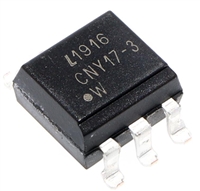STATISTICAL PROCESS CONTROL
Communication Power & Signal Technologies Group
(CPSTG) is continually pursuing new ways to improveproduct
quality. Initial design improvement is one method that can be
used to produce a superior product. Equally important to
outgoing product quality is the ability to produce product that
consistently conforms to specification. Process variability is
the basic enemy of semiconductor manufacturing since it
leads to product variability. Used in all phases of Motorola’s
productmanufacturing, STATISTICAL PROCESS CONTROL
(SPC) replaces variability with predictability. The traditional
philosophy in the semiconductor industry has been
adherence to the data sheet specification. Using SPC
methods ensures that the product will meet specific process
requirements throughout the manufacturing cycle. The
emphasis is on defect prevention, not detection. Predictability
through SPC methods requires the manufacturing culture to
focus on constant and permanent improvements. Usually,
these improvements cannot be bought with state–of–the–art
equipment or automated factories. With quality in design,
process, and material selection, coupled with manufacturing
predictability, Motorola can produce world class products.
The immediate effect of SPC manufacturing is predictability
through process controls. Product centered and distributed
well within the product specification benefits Motorola with
fewer rejects, improved yields, and lower cost. The direct
benefit to Motorola’s customers includes better incoming
quality levels, less inspection time, and ship–to–stock
capability. Circuit performance is often dependent on the
cumulative effect of component variability. Tightly controlled
component distributions give the customer greater circuit
predictability. Many customers are also converting to
just–in–time (JIT) delivery programs. These programs require
improvements in cycle time and yield predictability achievable
only through SPC techniques. The benefit derived from SPC
helps the manufacturer meet the customer’s expectations of
higher quality and lower cost product.
–6σ –5σ –4σ –3σ –2σ –1σ
0
1σ 2σ 3σ 4σ 5σ 6σ
Standard Deviations From Mean
Distribution Centered
At ± 3σ 2700 ppm defective
Distribution Shifted ± 1.5
66810 ppm defective
93.32% yield
99.73% yield
At ± 4σ 63 ppm defective
6210 ppm defective
99.379% yield
99.9937% yield
At ± 5σ 0.57 ppm defective
233 ppm defective
99.9767% yield
99.999943% yield
At ± 6σ 0.002 ppm defective
3.4 ppm defective
99.99966% yield
99.9999998% yield
Figure 1. AOQL and Yield from a Normal
Distribution of Product With 6σ Capability
To better understand SPC principles, brief explanations
have been provided. These cover process capability,
implementation, and use.
PROCESS CAPABILITY
One goal of SPC is to ensure a process is CAPABLE.
Process capability is the measurement of a process to
produce products consistently to specification requirements.
The purpose of a process capability study is to separate the
inherent RANDOM VARIABILITY from ASSIGNABLE
CAUSES. Once completed, steps are taken to identify and
eliminate the most significant assignable causes. Random
variability is generally present in the system and does not
fluctuate. Sometimes, the random variability is due to basic
limitations associated with the machinery, materials,
personnel skills, or manufacturing methods. Assignable
cause inconsistencies relate to time variations in yield,
performance, or reliability.
Ultimately, Motorola will have Six Sigma capability on all
products. Thismeansparametricdistributionswillbecentered
withinthespecificationlimits, withaproductdistributionofplus
or minus Six Sigma about mean. Six Sigma capability, shown
graphically in Figure 1, details the benefit in terms of yield and
outgoing quality levels. This compares a centered distribution
versus a 1.5 sigma worst case distribution shift.
Traditionally, assignable causes appear to be random due
to the lack of close examination or analysis. Figure 2 shows
the impact on predictability that assignable cause can have.
Figure 3 shows the difference between process control and
process capability.
A process capability study involves taking periodic samples
from the process under controlled conditions. The
performance characteristics of these samples are charted
against time. In time, assignable causes can be identified and
engineered out. Careful documentation of the process is the
key to accurate diagnosis and successful removal of the
assignable causes. Sometimes, the assignable causes will
remain unclear, requiring prolonged experimentation.
Elements which measure process variation control and
capability are Cp and Cpk, respectively. Cp is the specification
width divided by the process width or Cp = (specification
width) / 6σ. Cpk is the absolute value of the closest
specification value to the mean, minus the mean, divided by
NewproductdevelopmentatMotorolarequiresmorerobust
design features that make them less sensitive to minor
variations in processing. These features make the
implementation of SPC much easier.
A complete commitment to SPC is present throughout
Motorola. All managers, engineers, production operators,
supervisors, and maintenance personnel have received
multiple training courses on SPC techniques. Manufacturing
has identified 22 wafer processing and 8 assembly steps
considered critical to the processing of semiconductor
products. Processes controlled by SPC methods that have
shown significant improvement are in the diffusion,
photolithography, and metallization areas.
half the process width or Cpk = closest specification – /3σ.
X
Motorola Small–Signal Transistors, FETs and Diodes Device Data
Reliability and Quality Assurance
9–17










 压敏电阻器在直流电路中的过压保护应用探讨
压敏电阻器在直流电路中的过压保护应用探讨

 电感耐压值及其与电感大小的关系
电感耐压值及其与电感大小的关系

 CNY17F光耦合器:特性、应用、封装、引脚功能及替换型号解析
CNY17F光耦合器:特性、应用、封装、引脚功能及替换型号解析

 DS1307资料解析:特性、引脚说明、替代推荐
DS1307资料解析:特性、引脚说明、替代推荐
